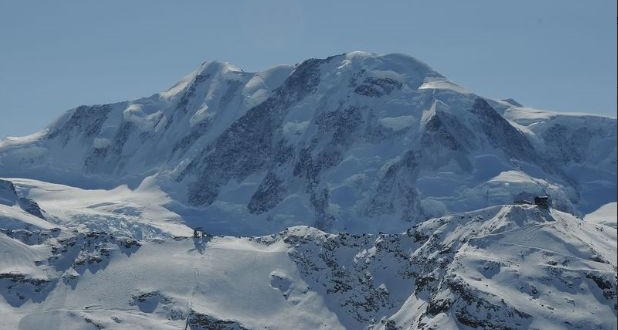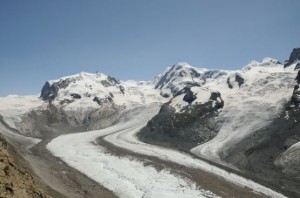The Liskamm is almost 50 meters higher than the Matterhorn and has a very long ridge. The mountain is nicknamed the “Man-eater” because in former days many climbers fell to their deaths from the snow cornices along the ridge. Locals attributed the numerous accidents of the forces of darkness. The Liskamm or often written Lyskamm is located to the west of the Monte Rosa group. The east summit at 4527 meters is the highest point of the ridge, which is about 2.5 kilometers long and crowns the ice-covered north east face, at nearly 1000 meter high. Ridge ascents are long and dangerous as the ridge has a tendency to form cornices even though technically speaking, the climbs are not particularly difficult.
Until the 1940s the Liskamm still bore names such as Monte Rosa, Monte Rosa summit, small Monte Rosa and Rosenhorn. Another name that the mountain carries today is “Silberbast”. “Silber” meaning “silver” and “Bast” designates the wooden pack-saddle that pack mules carried when transporting goods. This saddle has raised parts at the front and back, rather like the Liskamm with its two summits. This name derives from the imagination of Canon Berchtold and was readily adopted by the Zermatt guides. Nevertheless, the name “Liskamm” suggested by Freiherr Ludwig von Welden became established. The Lys is 40 meter long river which rises from the Italian side of the glacial arms of the Liskamm.
Due to lack of knowledge about the danger of cornices, many tragedies occurred on the Liskamm in the 19th century. Rope teams were much too large, and as they walked across deposits of snow that had built up on the crests and outcrops, these collapsed under the weight. But the superstition of the local people attributed the frequent accidents to the dark forces of the Liskamm. On September 6th 1877, for example, a single cornice fracture sent three brothers to their deaths, Niklaus, Johann and Peter-Josef from the well known Knubel mountain guide family from St.Niklaus.
The eastern and higher of the two peaks at 4527 meters was first ascended in 1861 from the Lysjoch up the east ridge by 14 man team led by J.F. Hardy and William Edward Hall. The ridge as a whole as well as the western summit, was first ascended three years later in 1865 by Leslie Stephen, Edward Buxton, Jakob Anderegg and Franz Biener. The normal route starts from the Lysjoch, which can be accessed from the Gnifetti hut or from the Monte Rosa hut. The route follows the route taken by the first ascentionists. The mountain is often climbed as a traverse from the Feliksjoch to the Lysjoch or vice versa. The traverse consists mostly of a narrow, snow covered ridge, with some scrambling over rocks. In good conditions, this route is fairly easy and objectively safe, however in bad snow conditions and or bad visibility, the ridge can be challenging because of large, sometimes double cornices which is mainly on the southern side of the ridge.


